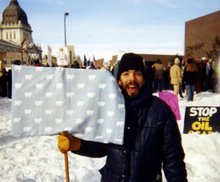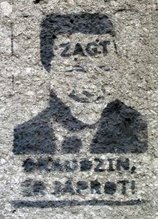
This is a photo of a portion of Old Riga from the spire of St. Peter's Church that is located in the center of the old town. In the center-left you can see the Brivibas Piemineklis (the Freedom Monument), one of Latvia's most recognizable landmarks. Behind the monument is the highrise hotel that was the main, Soviet-era hotel for foreigners and for visiting Soviet apparatchiki, and which is now the 4-star Hotel Latvia. In the lower right of the photo you can see the shadow of St. Peter's. St. Peter's is said to have once been the tallest structure in Europe. I don't know how true this claim is; they also say that the first Christmas tree to be erected, at least in a public square in Europe, was in Old Riga.
This momument was built in 1935, during Latvia's interwar period of independence. The inscription on the monument reads, "For Fatherland and Freedom," a phrase that was adopted as a name by one of Latvia's most important post-Soviet political parties. The woman-figure at the top of the monument is often refered to affectionately as Milda by Latvians, something like a Mother Latvia. Someone also once told me that they think of her as Laime--the name of the Latvian pagan Goddess of Good Fortune and the Future, and also a common woman's name. The three stars originally represented the three predominantly-Latvian provinces that were wrestled from the Russian Empire to create the first independent state of Latvia (declared in 1918, recognized internationally in 1921; see Latvian History Wikipedia). Since the territory of Latvia was organized into 4 provinces after Soviet independence, some people today say the stars represent the three Baltic states. In Soviet times, the woman at the top of the statue was supposed to represent the Motherland--either the Soviet Union or Mother Russia--supporting the three Baltic states.
The square and monument became the locale of numerous anti-Soviet, pro-Independence demonstrations that took place throughout the glasnost period. It is often said that the anti-Soviet movement in Latvia went public and above-ground on June 17, 1987, the day when the Latvian human rights group Helsinki-86 held a ceremony during which participants laid flowers at the base of the monument. The ceremony was held in commemoration of June 17, 1941, or the day on which the Soviet government deported 14,000 Latvians as it began its occupation of Latvia. Many Latvians living in the USSR maintained a private tradition of commemorating this day at home, while those in the diaspora held yearly, public events. Needless to say, it was a powerful moment for many when this day was marked in public for the first time in Latvia.
Though much happened in the interim, one of the most dramatic--and certainly the most deadly of--events in the course of the independence struggle took place on January 20, 1991.
ABOUT THE JANUARY 20, 1991 MASSACRE IN RIGA:
 Above is a foto of what once was a moat that was part of Riga's medieval and early modern fortifications. Today it is a canal upon which one can paddle 2-person boats or along the shores of which one can enjoy a beer (or two or three or four).
Above is a foto of what once was a moat that was part of Riga's medieval and early modern fortifications. Today it is a canal upon which one can paddle 2-person boats or along the shores of which one can enjoy a beer (or two or three or four).But to return to the history lesson here, the January 20, 1991 massacre took place along its banks.
Latvia declared its independence from the Soviet Union in May of 1990. For months following the declaration, a tense series of negotiations between Latvian and Soviet authorities took place. Throughout the long negotation period, various pro-Independence demonstrations took place throughout the country. Then, in January of 1991, someone--it has yet to be determined who ordered the crackdown--within the Soviet authority decided the time had come to do something about the breakaway Baltic Republics (both Lithuania and Estonia had made similar moves toward independence as Latvia). The crackdown began in Vilnius on January 11 (read here for starters), the day on which Soviet troops began to seize control of various buildings and strategic locations throughout Lithuania. On January 13, 14 people were killed and 700 hundred were injured as Soviet paratroopers tried to seize control of the TV Tower in Vilnius, which had come under the control of pro-Independence forces.
These events in Vilnius triggered people in Latvia to build barricades around their strategically important buildings and locations as well, including in Riga the parliament building, the TV tower, and the Ministry of the Interior. Each of these buildings were occupied by pro-Independence cadre and were defended by thousands of people who kept watch, night and day, at barricades erected before them. People waited in fear of a repeat in Riga of events in Vilnius.
And the repeat took place on January 20.
Across the street from the canal and not far from the Freedom Monument pictured above is the building of what was then and still is the Ministry of the Interior.
 Latvia's Ministry of the Interior as it appears today.
Latvia's Ministry of the Interior as it appears today. Today, directly across the street from it is the US embassy.
 On January 20, 1991, Soviet Black Berets opened fire on the building, firing live rounds over the heads of those staffing the barricades. However, no attempt was made to take the building.
On January 20, 1991, Soviet Black Berets opened fire on the building, firing live rounds over the heads of those staffing the barricades. However, no attempt was made to take the building.You can see in the photo above the marks made by bullets striking the building--they have been left as a monument to what happened on that day.
The Soviet troops also opened fire on the crowd that had gathered directly across the street.
 In the park across the street were more barricades and demonstrators upon which the Soviet troops opened fire. 5 people were killed, more or less on the spot. The number varies as to how many were wounded, but it seems that the consensus is hundreds. Today rocks mark the spots where those who were killed fell, with each rock baring the victim's name and occupation.
In the park across the street were more barricades and demonstrators upon which the Soviet troops opened fire. 5 people were killed, more or less on the spot. The number varies as to how many were wounded, but it seems that the consensus is hundreds. Today rocks mark the spots where those who were killed fell, with each rock baring the victim's name and occupation. One of those killed was Andris Slapiņš, a dissident filmmaker who for years had been actively documenting the fall of the Soviet Union. It seems that he was singled out by sniper fire. Slapiņš and his camera operator/friend were filming the events taking place when he was shot. They had positioned themselves on the side of the bridge pictured above, on the side opposite of the Ministry of the Interior, where they could have a wide view of what was taking place. It is said that as he laid on the ground, quickly bleeding to death, Slapiņš shouted to his friend, "Film me! Film me! They got me right in the heart!"
One of those killed was Andris Slapiņš, a dissident filmmaker who for years had been actively documenting the fall of the Soviet Union. It seems that he was singled out by sniper fire. Slapiņš and his camera operator/friend were filming the events taking place when he was shot. They had positioned themselves on the side of the bridge pictured above, on the side opposite of the Ministry of the Interior, where they could have a wide view of what was taking place. It is said that as he laid on the ground, quickly bleeding to death, Slapiņš shouted to his friend, "Film me! Film me! They got me right in the heart!"Throughout the year people put flowers and candles on these stones that mark the spots where people like Slapiņš fell, but they especially do so every year on January 20.
I would like to mention something here about the process of the Soviet collapse that I think the grassroots history that lead to events like January 20 and the eventual independence of Latvia suggests:
The Sovietological and nearly hegemonic story of a top-down collapse of the USSR is, to my mind and that of others (see, for example, this book) far too limiting in its explanation of what was a much more complicated reality, especially as it is far too dismissive of the role played by grassroots pressure that first bubbled then boiled from the bottom-up. Grassroots pressures and everyday forms of resistance to Soviet rule and Soviet society in general were a significant, if not leading cause that made the system buckle and eventually fall--and it was bottom-up pressures that bubbled up most forcefully in the east-central European satellite states and from Western Ukraine and the Baltic States that played a most significant role in igniting the process of change that then spun out of control and resulted in collapse.











No comments:
Post a Comment